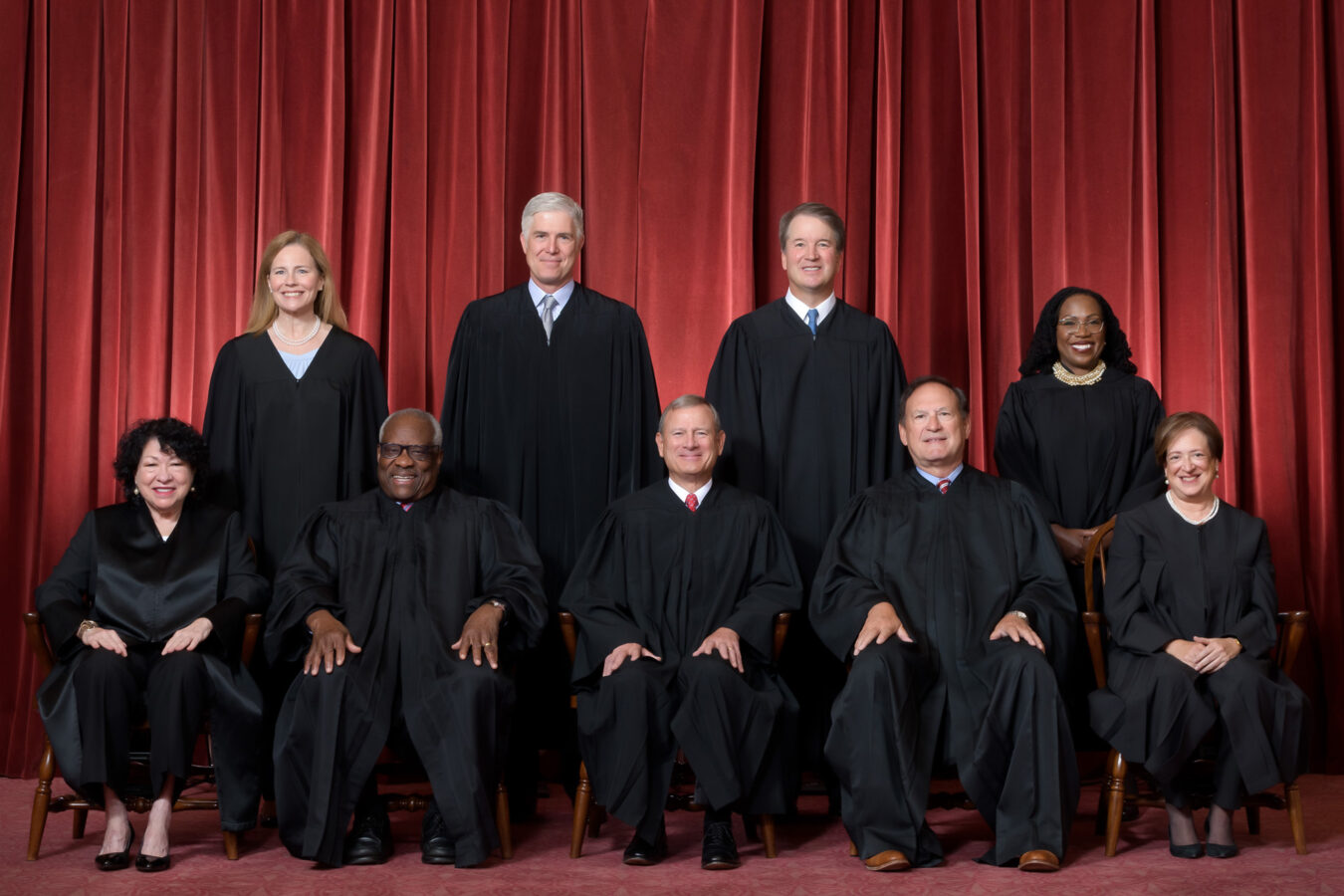How Many Justices Are on the Supreme Court in 2024
Who are the 9 justices on the Supreme Court in 2024?
The Supreme Court of the United States has had nine justices for over 150 years, but its size is not set in stone. Over the course of U.S. history, Congress has passed legislation altering the number of justices on multiple occasions. Most recently, there have been calls from some Democratic lawmakers to expand the size of the Court following the confirmation of three conservative justices during Donald Trump’s presidency.
So how many justices currently sit on the nation’s highest court? Let’s review the history and context behind the Supreme Court’s composition.
History of the Supreme Court’s Size
The Judiciary Act of 1789
Article III of the U.S. Constitution established the Supreme Court but left specifics like the number of justices up to Congress. In the Judiciary Act of 1789, the first Congress set the original size of the Supreme Court at six justices.
Over the following decades, changes to the Court were politically contentious. The familiar number of nine justices wasn’t established until 1869.
Changes Over Time
In 1801, the outgoing Federalist Party reduced the Court’s size to five in order limit incoming president Thomas Jefferson’s appointments. This change was quickly repealed by Jeffersonian Republicans after the next election.
Later, in 1837, two new justices were added to strengthen Jacksonian majorities on the Taney Court. Yet in 1866, Congress shrank the Court from 10 members to seven after Andrew Johnson became president. Johnson’s clashes with Congress partially explain this move.
Finally, in 1869, the Circuit Judges Act returned the Supreme Court to nine justices, the current number. President Ulysses S. Grant soon after signed the act into law.
Recent Calls to Expand the Court
Following the contentious confirmation processes of Neil Gorsuch, Brett Kavanaugh, and Amy Coney Barrett under President Trump, some Democratic legislators introduced proposals to expand the Supreme Court beyond nine justices.
President Biden responded by assembling a commission to study Court reform options, but the commission was split on whether Court expansion would be wise or politically viable. The possibility remains an ongoing source of debate.
Who is the chief justice of the United States in 2024?
The chief justice of the United States is currently John G. Roberts, Jr.
The 17th chief justice, Roberts was appointed by President George W. Bush and sworn in on September 29, 2005.
Justices – Supreme Court
Current Composition of the Supreme Court
How many Supreme Court justices are there?
Nine Seats
In 2024 there remain nine Supreme Court associate justices, consistent with the Judiciary Act of 1869. One chief justice presides over the eight associate justices.
Who are the 9 justices on the Supreme Court in 2024?
List of Current Justices
The Supreme Court Current Members:
- Chief Justice John Roberts (appointed in 2005)
- Clarence Thomas (appointed 1991)
- Samuel Alito (appointed 2006)
- Sonia Sotomayor (appointed 2009)
- Elena Kagan (appointed 2010)
- Neil Gorsuch (appointed 2017)
- Brett Kavanaugh (appointed 2018)
- Amy Coney Barrett (appointed 2020)
- Ketanji Brown Jackson (appointed 2022)
This totals nine justices, with six justices appointed by Republican presidents and three by Democratic presidents.
The United States Supreme Court currently has 9 justices in 2024. However, the number of justices serving on the Supreme Court has fluctuated over time.
John G. Roberts, Chief Justice
Background and career
John G. Roberts, Jr., Chief Justice of the United States, was born in Buffalo, New York, January 27, 1955. He married Jane Sullivan in 1996 and they have two children – Josephine and Jack. He received an A.B. from Harvard College in 1976 and a J.D. from Harvard Law School in 1979. He served in various legal positions before being appointed to the D.C. Circuit Court of Appeals in 2003.
Appointment to Supreme Court
Nominated as Chief Justice of the United States by President George W. Bush, he assumed that office on September 29, 2005.
Clarence Thomas, Associate Justice
Background and career
Clarence Thomas, Associate Justice, was born in the Pinpoint community near Savannah, Georgia on June 23, 1948. He attended seminary and graduated from College of the Holy Cross and Yale Law School. He held positions in the Missouri and federal governments before serving as Chairman of the EEOC from 1982-1990 and a federal appeals judge from 1990-1991. He married Virginia Lamp in 1987 and has one child, Jamal Adeen.
Appointment to Supreme Court
President Bush nominated him as an Associate Justice of the Supreme Court, and he took his seat October 23, 1991.
Samuel A. Alito, Jr., Associate Justice
Background and career
Samuel A. Alito, Jr., Associate Justice, was born in Trenton, New Jersey, on April 1, 1950. He married Martha-Ann Bomgardner in 1985, and has two children – Philip and Laura. He held various legal positions before being appointed to the Third Circuit Court of Appeals in 1990.
Appointment to Supreme Court
President George W. Bush nominated him as an Associate Justice of the Supreme Court, and he took his seat January 31, 2006.
Sonia Sotomayor, Associate Justice
Background and career
Sonia Sotomayor, Associate Justice, was born in Bronx, New York, on June 25, 1954. She earned degrees from Princeton and Yale Law School. She served as a prosecutor, private practice attorney, and federal district and appeals court judge before joining the Supreme Court.
Appointment to Supreme Court
President Barack Obama nominated her as an Associate Justice of the Supreme Court on May 26, 2009, and she assumed this role August 8, 2009.
Elena Kagan, Associate Justice
Background and career
Elena Kagan, Associate Justice, was born in New York, New York, on April 28, 1960. She earned degrees from Princeton, Oxford, and Harvard Law School. She clerked for a judge and Supreme Court justice, and also held positions in academia, private legal practice, and the Clinton White House. From 2003-2009 she was Dean of Harvard Law School, and in 2009 became Solicitor General under President Obama.
Appointment to Supreme Court
President Obama nominated her as an Associate Justice of the Supreme Court on May 10, 2010. She took her seat on August 7, 2010.
Neil M. Gorsuch, Associate Justice
Background and career
Neil M. Gorsuch, Associate Justice, was born in Denver, Colorado, August 29, 1967. He received degrees from Columbia, Harvard Law, and Oxford, and clerked for judges on the D.C. Circuit and Supreme Court. He worked in private practice from 1995-2005, before becoming Principal Deputy Associate Attorney General. He was appointed to the Tenth Circuit Court of Appeals in 2006.
Appointment to Supreme Court
President Donald J. Trump nominated him as an Associate Justice of the Supreme Court, and he took his seat on April 10, 2017.
Brett M. Kavanaugh, Associate Justice
Background and career
Brett M. Kavanaugh, Associate Justice, was born in Washington, D.C., on February 12, 1965. He married Ashley Estes in 2004, and they have two daughters. He graduated Yale College and Yale Law School. He clerked for judges on the Third Circuit and Ninth Circuit, and for Justice Kennedy. He worked in the Solicitor General’s Office, Office of Independent Counsel, and White House under President Bush. He was appointed to the D.C. Circuit Court in 2006.
Appointment to Supreme Court
President Donald J. Trump nominated him as an Associate Justice of the Supreme Court, and he took his seat on October 6, 2018.
Amy Coney Barrett, Associate Justice
Background and career
Amy Coney Barrett, Associate Justice, was born in New Orleans, Louisiana, on January 28, 1972. She married Jesse M. Barrett in 1999, and they have seven children. She graduated Rhodes College and Notre Dame Law School. She clerked for judges on the D.C. Circuit and Supreme Court before becoming a law professor at Notre Dame in 2002. She was appointed to the Seventh Circuit Court of Appeals in 2017.
Appointment to Supreme Court
President Donald J. Trump nominated her as an Associate Justice of the Supreme Court, and she took her seat on October 27, 2020.
Ketanji Brown Jackson, Associate Justice
Background and career
Ketanji Brown Jackson, Associate Justice, was born in Washington, D.C., on September 14, 1970. She married Patrick Jackson in 1996, and they have two daughters. She graduated magna cum laude from Harvard-Radcliffe College and cum laude from Harvard Law School. She clerked on the federal district court, First Circuit, and for Justice Breyer. She served as an assistant federal public defender and U.S. Sentencing Commissioner before being appointed district court judge in 2013 and circuit court judge in 2021.
Appointment to Supreme Court
President Joseph R. Biden, Jr., nominated her as an Associate Justice of the Supreme Court in 2022. She took her seat on June 30, 2022.
Retired Justices
Anthony M. Kennedy
Background and career
Anthony M. Kennedy (Retired), Associate Justice, was born in Sacramento, California, July 23, 1936. He married Mary Davis and has three children. He received degrees from Stanford, the London School of Economics, and Harvard Law. He worked in private practice and was a constitutional law professor before being appointed to the Ninth Circuit Court of Appeals in 1975.
Retirement
Justice Kennedy retired from the Supreme Court on July 31, 2018.
David Hackett Souter
Background and career
David H. Souter (Retired), Associate Justice, was born in Melrose, Massachusetts, September 17, 1939. He graduated Harvard College, Oxford University, and Harvard Law School. He worked in the New Hampshire state government and was appointed to the state and federal courts before joining the Supreme Court in 1990.
Retirement
Justice Souter retired from the Supreme Court on June 29, 2009.
Stephen G. Breyer
Background and career
Stephen G. Breyer (Retired), Associate Justice, was born in San Francisco, California, August 15, 1938. He graduated from Stanford, Oxford, and Harvard Law School. He served as special counsel during the Watergate scandal, and also worked in academia, the federal judiciary, and the U.S. Sentencing Commission before joining the Supreme Court in 1994.
Retirement
Justice Breyer retired from the Supreme Court on June 30, 2022.
Are there 9 or 11 Supreme Court justices?
The Constitution Does Not Specify the Number of Justices
The Constitution does not set a specific number of justices to sit on the Supreme Court. Article III states that there shall be one Supreme Court, but leaves it up to Congress to determine its composition. Over the course of American history, Congress has passed various laws setting the number of justices.
The Number Has Changed Over Time
Originally 6 Justices
The Judiciary Act of 1789, which established the federal court system, set the number at six justices. This included one Chief Justice and five associate justices.
Fluctuated Between 6 and 10 in the 1800s
In the 19th century, the number ranged between six and ten justices:
- 1801: Expanded to 7 justices
- 1807: Reduced back to 6 justices
- 1837: Expanded to 9 justices
- 1863: Expanded to 10 justices
- 1866: Reduced to 7 justices
Why are there 9 justices on the Supreme Court?
Set at 9 in 1869
The Judiciary Act of 1869 formally set the number of justices at nine, which is still in place today.
FDR’s Failed Court Packing Plan
In 1937, President Franklin D. Roosevelt unsuccessfully attempted to expand the court in order to appoint more liberal leaning judges. This “court packing plan” was met with widespread criticism and ultimately rejected by Congress.
Current Number is 9 Justices
Set by the Judiciary Act of 1869
As mentioned above, the Judiciary Act of 1869 set the Supreme Court at nine members, which has now remained unchanged for over 140 years.
One Justice for Each of the Circuit Courts of Appeals
At the time the law was passed, there were nine Circuit Courts that served under the Supreme Court. The Act aligned the number of Supreme Court justices with the number of lower circuit courts.
Possibility of Expanding the Court Remains
While nine justices have served together for many decades now, there have still been occasional calls to expand the court.
FDR’s Attempt and Continued Debate
After FDR’s failed effort in 1937, expansion of the court continues to be debated from time to time. Generally those in favor argue additional justices would allow various presidents to shape the ideological balance of the court.
Liberals Advocate Expansion to Counter Conservative Majority
In recent years, some liberal politicians and activists have pushed for adding justices to counter what they see as an excessively conservative court aligned too far from mainstream public opinion on many issues. However, any change would require legislation passed by Congress.
Why 9 Justices – Historical Reasoning
While there are occasional political pushes to change the number, the size of nine has clear historical reasoning behind it.
Matching the Number of Circuit Courts of Appeals
As mentioned earlier, at the time the number was set in 1869, nine matched the number of lower federal circuit courts in place around the country.
Precedent for Over 140 Years
Additionally, nine justices have now served together for over 140 consecutive years, setting a strong precedent. Dramatically altering such an enduring American institution would likely require substantially compelling political and legal arguments.
What is the Supreme Court justices’ salary in 2024?
According to the federal court system, the chief justice of the United States makes $286,700 annually, while the associate justices make $274,200.
What are the ages of Supreme Court justices in 2024?
From oldest to youngest, the ages of the current Supreme Court justices are:
Justice Thomas, 75
Justice Alito, 73
Justice Sotomayor, 69
Chief Justice Roberts, 68
Justice Kagan, 63
Justice Kavanaugh, 58
Justice Gorsuch, 56
Justice Jackson, 53
Justice Barrett, 51
Implications of the Current Size
Pros
Proponents argue nine justices creates more stability and consistency in the Court’s decisions. It also limits opportunities for any single president to dramatically shift the Court’s ideological balance for decades to come through many new appointments.
Nine justices allows for a diversity of perspectives when reviewing cases while still fostering collegial deliberations and the ability to come to consensus.
Cons
However, having only nine justices means that losses due to retirements or deaths can significantly impact the Court. For example, Justice Scalia’s sudden death led to a long vacancy that allowed President Trump to appoint the successor.
Some argue that more justices could improve functioning by allowing the Court to hear more cases. The Court currently rejects over 7,000 petitions annually. More justices could help address this backlog.
Possibility of Future Expansion
Political Context
While altering the Supreme Court’s size could be done through regular legislation, it remains unlikely the current divided Congress would pass any sweeping reform. Most Republicans and some moderate Democrats oppose Court expansion.
Biden’s Presidential Commission
President Biden’s Supreme Court commission published analysis arguing that Court expansion could undermine the Court’s legitimacy. Yet it noted such legislation isn’t necessarily unconstitutional either.
Overall, expanding the Supreme Court faces an uphill political battle despite support from some vocal Democrats. Barring wider legislative and popular support, the Court seems poised to retain nine justices for now.
Conclusion
For over 150 years since the Judiciary Act of 1869, the Supreme Court has consisted of the chief justice and eight associate justices, totaling nine members. While its size has fluctuated throughout history, the make-up established in 1869 has proven enduring.
Today in 2024, there is little indication Congress plans to alter the status quo anytime soon. With President Biden’s reform commission declining to unite behind Court expansion, nine justices remain seated on the bench to interpret the nation’s laws.
Summary
- The U.S. Constitution doesn’t mandate how many justices serve on the Supreme Court. Congress sets the number by legislation.
- Early laws fluctuated the Court’s size between six and ten justices until the Judiciary Act of 1869 permanently set the number at nine.
- In 2024, nine justices serve on the Supreme Court – one chief justice and eight associate justices. Six were nominated by Republican presidents and three by Democratic presidents.
- While some Democrats advocate expanding the Court after recent conservative appointments, such reform currently lacks majority support in Congress.
Frequently Asked Questions
Q: How many Supreme Court justices are there in 2024?
A: There are nine Supreme Court justices – one chief justice and eight associate justices.
Q: When was the number of justices set at nine?
A: The Judiciary Act of 1869 established nine as the number of Supreme Court justices.
Q: Who are the nine current Supreme Court justices?
A: The nine justices are Chief Justice John Roberts and Associate Justices Clarence Thomas, Samuel Alito, Sonia Sotomayor, Elena Kagan, Neil Gorsuch, Brett Kavanaugh, Amy Coney Barrett, and Ketanji Brown Jackson.
Q: Is the Supreme Court likely to expand beyond nine justices?
A: Expanding the Court faces political barriers in Congress, making it unlikely in the near future despite some proposals from Democrats.
Q: Could Congress change the law to alter the number of Supreme Court justices?
A: Yes, Congress can pass new legislation setting a different number of justices, as was done multiple times in the Court’s early history.
Who is the highest paid justice on the Supreme Court?
The chief justice of the United States, currently John Roberts, has the highest salary at $286,700 per year.
How much do associate Supreme Court justices make per year?
The eight associate justices each earn an annual salary of $274,200.
Who are the oldest Supreme Court justices currently serving?
The oldest three justices are Clarence Thomas at 75, Samuel Alito at 73, and Sonia Sotomayor at 69.
Who is the youngest justice currently on the Supreme Court?
Justice Ketanji Brown Jackson, appointed in 2022, is the youngest on the Supreme Court at 53 years old.
How many justices are in their 40s or 50s right now?
Three justices are still in their 50s – Jackson, Barrett, and Gorsuch. There are currently no justices in their 40s serving on the court.
How many justices are on the Supreme Court?
There are currently nine justices on the Supreme Court – one Chief Justice and eight Associate Justices.
How long do justices serve on the Court?
Supreme Court justices serve lifetime appointments after being nominated by the President and confirmed by the Senate. Justices may choose to retire or resign at any time.
Who nominates Supreme Court justices?
The President of the United States nominates individuals to serve on the Supreme Court. The nominee must then be confirmed by a majority vote of the Senate.
What qualifications are required to become a Supreme Court justice?
There are no official qualifications, but justices have generally served as judges, lawyers, law professors, or in a related field requiring extensive legal training and experience interpreting and arguing the law.
How are vacancies on the Court filled?
When a vacancy occurs on the Court due to a justice’s retirement, death, or resignation, the President nominates a replacement and the Senate votes to confirm. The new justice is appointed for life or until voluntary retirement.







